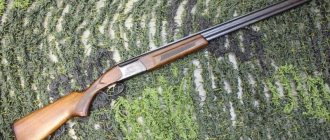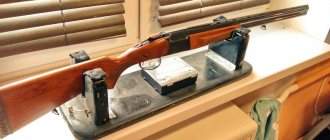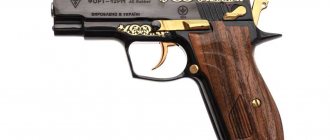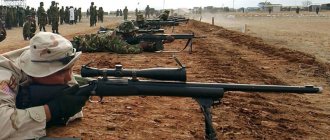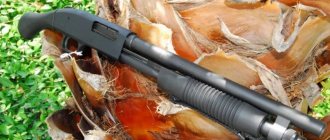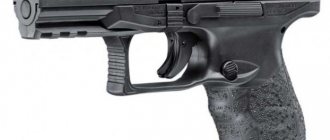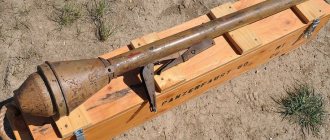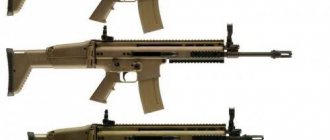General characteristics of pump-action weapons
Shooting from a pump-action shotgun is carried out as follows. To fire a shot, it is necessary to exert a mechanical force forward or backward on the sliding front handle (in other words, to distort this handle). When the handle moves back and forth, it moves the bolt mechanism. As a result, the spent cartridge case is ejected, and a new charge is sent to the chamber, and the next shot occurs.
Probably, each of us has at least once seen some kind of action movie in which the hero famously deals with ill-wishers using a pump-action weapon, vigorously jerking the shutter and firing almost automatically.
It is believed that the mechanism of a pump-action weapon is much more effective than that of classic hunting rifles, since it can be controlled much faster due to the fact that when shooting, the hand does not remove from the handle until the weapon runs out of charges. If a gun can be reloaded faster, then, consequently, fire from it can be fired more intensely. So the classic Hollywood superhero is not entirely fiction: with good skill, you can indeed shoot much faster from a pump-action shotgun than from a traditional hunting weapon.
By the way, the method of reloading a pump-action weapon is usually called a sliding forend.
In addition to pump-action shotguns, there is also a pump-action rifle, as well as a pump-action grenade launcher. If we do not take into account rifles and grenade launchers and talk exclusively about pump-action shotguns, then we can say that all of them are conditionally divided into two types: hunting shotguns and shotguns for self-defense. Let's look at both of these varieties.
Main disadvantages
Of course, listing all the advantages that 20 gauge has, one cannot fail to mention the disadvantages - nothing can do without them.
First of all, this is a smaller amount of shot or buckshot and, accordingly, a smaller affected area. This reduces the chances of a successful shot, especially if the shooting is carried out at a long distance. However, we will return to this issue a little later.
Range is a controversial factor. Some shooters argue that the smaller powder load leads to the fact that the reliable combat distance of the 12 gauge is much greater than that available for the 20. Others believe that the reduced barrel diameter completely compensates for the small powder load, resulting in the same pressure being created.
But what is undoubtedly a minus is the fact that 20-gauge cartridges are much more difficult to find on sale than 12 and 16. For some reason, despite serious demand, many medium and small stores where 12-gauge cartridges are presented in a huge assortment, they either don’t buy anything less than the popular 20 at all, or they do it very carefully, purchasing little by little.
However, if you don’t trust purchased cartridges too much, preferring to load them the old fashioned way, on your own, the last factor is unlikely to scare you. It is enough to once buy high-quality (preferably brass, if you do not use a semi-automatic shotgun) 20-caliber cartridge cases - they will last for many years even with very active shooting. Well, purchasing gunpowder, a primer and suitable ammunition will not be difficult - they are sold in any hunting store. The only thing that will cause problems in this case is the wads and containers - they must exactly match the specific caliber. However, you can easily make the first ones yourself, having once spent a relatively small amount on a pyzherub. Well, not all hunters who load cartridges themselves use containers. Yes, refusing them reduces the distance of a confident fight. But it reduces the cost of each cartridge by 2-3 rubles, while at the same time providing greater spread of shot or buckshot, increasing the likelihood of hitting prey.
Pump-action shotguns for self-defense
Let's start with the fact that the law allows the use of any smoothbore gun for self-defense. Of course, here you can use a regular double-barreled or single-barreled shotgun, but many experts recommend purchasing a “pump” for this purpose, assuring that such a weapon is much more reliable than a traditional gun:
- A pump-action shotgun, depending on its brand, has from 4 to 8 charges. It is clear that it is easier to protect yourself with such a number of charges than with 1-2 charges in a single-barreled or double-barreled gun;
- Thanks to the design features, the “pump” can fire faster than a conventional gun;
- A shot from a pump-action shotgun has very solid stopping and striking characteristics, not inferior to a shot from a machine gun;
- Many pump-action weapons have a short barrel. Since you usually have to defend yourself or your loved ones from a short distance, a short-barreled weapon that gives you the opportunity to maneuver is more suitable here.
Of course, in order to purchase such a weapon, you need a special permit. Possession of a weapon, and even more so shooting from it without permission, can lead to trouble with the law.
What kind of mining is this caliber suitable for?
In general, it is difficult to list all the prey for which these guns are suitable - that’s why the 20 gauge receives mostly positive reviews from hunters.
Of course, you shouldn’t take it when going after a really large and dangerous animal. For example, a bullet fired from such a gun will seriously injure a bear or an elk and make it very angry - the hunter will have little chance of surviving such an encounter. It can only be taken on a wild boar as a last resort. But otherwise there are no restrictions. Roe deer, hare, moose whale, duck, black grouse, goose, squirrel, quail, woodcock - all of them can become worthy trophies for a good hunter.
This caliber is highly valued by fur-bearing hunters. Still, using a smaller caliber is not a very good idea, since 28 does not provide sufficient combat range. A larger one will simply turn the skin of an unfortunate squirrel or sable into a real colander - using it later will be quite problematic. But not everyone has the opportunity to use rifled weapons, which leave only two tiny holes. Thus, TOZ or “Saiga” 20 caliber will become a really good choice for fur hunters – domestic trappers.
The most popular pump-action shotguns for self-defense
Here is a list and brief characteristics of the most famous brands of pump-action shotguns intended for self-defense:
- Remington pump action shotguns. There are several modifications of shotguns of this brand, differing in caliber: 12 gauge, as well as 16, 20 and 28 gauge. The Remington has a steel body, the magazine capacity is 3 charges, and if there is a magazine extension, then 8 charges. The gun is equipped with a folding charge made of polymer materials, a pistol grip, and a forend. In addition, the gun is equipped with a Picattini rail for equipping the gun with a flashlight, a laser designator and a collimator sight. Remington shotguns are considered one of the best weapons in this class;
- Mossberg 500 pump action shotgun. This modification is made in the USA. The version of this gun, intended for self-defense, has calibers 12, 20 and 410. Its barrel length is 510 mm. Magazine capacity – 8 charges. Unlike other models, the Mossberg is equipped with a fuse located not on the side, but on the top. When shooting, the safety can be easily switched with the movement of a finger. The price of the gun is quite high, but there is a not so expensive analogue of this weapon - the Mexican “Maverick 88”;
- Winchester 1300 pump action shotgun. Made in the USA. In terms of reliability, it is considered one of the best in its class. The receiver is made of aluminum alloy. Caliber – 12/76 mm. There are many versions of Winchester shotguns, but for self-defense purposes, the version with a barrel length of 457 mm has proven itself best. Unlike other guns, it is equipped with the original Speed Pump system. This system allows the weapon to be reloaded much faster than other brands of pump-action shotguns;
- MP-133 pump-action shotgun. This is a Russian-made weapon. The MP-133 shotgun is the most common and popular Russian pump-action weapon. The gun has a triple system that prevents an involuntary shot. Its receiver is made of aluminum alloy. The MP shotgun is produced in calibers of 12\70, 12\76 and 12\89 mm. In terms of self-defense, versions with barrel lengths of 510 and 540 mm are recommended;
- Pump-action shotgun "Hatsan Eskort AimGuarg". This is a Turkish-made weapon. Turkish pump-action shotguns have long gained fame, but this shotgun is one of the most popular Turkish shotguns. The gun has a wonderful, simply “fantastic” design, reliable quality and at the same time a relatively low price. Its caliber is 12\76 mm. The gun is equipped with a 450 mm barrel and also a 500 mm barrel. The magazine can hold 5 and 7 charges. The forend and butt are made of plastic.
Due to their characteristics and variety of modifications, the listed samples of pump-action weapons can, of course, also serve for hunting purposes.
However, it just so happens that they are mostly used for self-defense, so when purchasing a pump-action shotgun for self-defense, you need to remember that this is a very serious weapon that can provide excellent protection. However, such weapons can cause serious injury or even death, and, of course, when purchasing a gun, you should not forget about the purchase permit.
Let's sum it up
So, what can we say based on the results of the article?
Domestic 20-gauge shotguns are presented on the market in our country in a fairly large assortment, and if we also take into account foreign models, then there is no doubt: even the most demanding hunter can easily select exactly the gun that will fully meet all the requirements.
Should you choose a single-barreled, double-barreled or semi-automatic shotgun? It all depends on the shooter himself, his requirements for reliability, weight, ammunition and cost. It is impossible to give a definite answer in principle.
Shotguns are perfect for hunting most animals and birds that live in our country. Well, for fur hunters it will become simply an indispensable tool.
Finally, when in doubt when choosing between a gun for regular and reinforced cartridges, it makes sense to give preference to the former.
The most popular hunting pump-action shotguns
If history is to be believed, pump-action shotguns were conceived from the very beginning as hunting weapons, and not at all as military or civilian ones. The same story claims that the first pump-action hunting rifles appeared at the end of the 19th century. The “pump” began to turn into a military weapon with the beginning of the First World War.
There are probably even more versions of hunting pump-action shotguns produced than those shotguns that serve self-defense purposes. As a matter of fact, almost every well-known company in the world that produces pump-action weapons strives to make purely hunting versions of their products, as well as civilian pump-action weapons and similar weapons for military purposes. Here we will talk about the most popular pump-action brands for hunters, and domestic brands, since a lot has already been said about foreign “pumps”:
- Pump-action shotgun IZH-81. This is one of the examples of Russian pump-action hunting shotguns. In addition, this gun is the first domestic pump-action weapon. Its production began in 1994. From the very beginning, the weapon was very inferior to foreign competitors in terms of its characteristics. However, for some time it was very popular in the country - primarily as a means of self-defense. In addition, private security guards were armed with guns. The caliber of the gun was 12 (18.4 mm), the barrel had three lengths - 560, 600 and 700 mm. Trying to somehow improve the characteristics of the gun, its developers released several modifications: IZH-81K, IZH-81M, IZH-81KM, IZH-81 “Jaguar” (this version was produced with a pistol grip and without a stock), IZH-81 “Fox Terrier” (this version differed from others in having shortened barrels and a folding stock). At this time, the weapon is not produced, but it is quite common on the secondary market: people go hunting with it, it is used for self-defense. At the same time, its price is very low, which is primarily due to its relative imperfection;
- Pump-action shotgun "Bekas". This is another type of domestic pump-action shotgun. Moreover, this gun is much more advanced than the gun of the previous brand. The first modification of this gun was released in 1997. A little later, an improved modification appeared - Bekas Auto. The first version uses 16-gauge charges; Bekas Auto is designed to fire 16-gauge charges as well. Currently, many new versions of Bekas have been produced. Weapons are used for both hunting and self-defense.
In addition to the above-mentioned brands of domestic pump-action weapons, Russian gunsmiths have recently released several new brands.
Choosing the right ammunition
When going to load cartridges for a new gun for the first time or simply buying them in a store, some hunters will ask themselves: What is better: shot, buckshot or bullet?”
In general, the rules here are the same as when handling other calibers. Well, with the exception that 20-caliber bullets are primarily suitable for not the biggest prey - you can still kill a wild boar with them, but hardly an elk. But a deer hit by such a bullet will definitely not go far.
If you share the point of view that 20 gauge is much weaker than 12, and you are afraid that the charge will not penetrate the plumage of a large bird, such as a goose or wood grouse, then you can always take a shot 1-2 sizes larger. This completely compensates for the lower power, allowing you to return home with some truly impressive trophies.
As a final word
Pump-action weapons (both hunting and civilian versions) are widely distributed abroad (in the USA), but in Russia such weapons are not widespread. Firstly, because of the price. Russian analogues, despite their relative imperfections, are still significantly cheaper. Secondly, Russians have a different mentality and a different culture. When hunting, Russians prefer the good old double-barreled shotgun over pumps and all sorts of automatic equipment, and for self-defense, for example, the Saiga carbine.
By the way: in some US special forces the Saiga carbine is accepted as a standard weapon. That is, the Americans preferred Russian Izhmashev weapons to their “space” pump guns. Because it is better. Well, why do Russians need to defend themselves with “pomp”?
But, be that as it may, pump-action weapons have their own long-standing and well-deserved niche.
What does 20 gauge mean?
First, let's figure out what the number 20 in the name of the caliber means. Some novice hunters, who know that millimeters are used to indicate the caliber of rifled weapons in Russia, have difficulty navigating among 12, 20, 28 and 32 calibers. Many people are surprised how a 20 gauge or 32 gauge barrel can be smaller than a 12 or 16 gauge barrel.
In fact, everything is simple here - this calibration system is tied to the English pound, which is 454 grams. Caliber indicates how many bullets for a particular gun can be cast from a pound of lead. For example, if only 12 bullets can be cast for one large-caliber gun, then the caliber will be 12. But if you take a smaller caliber, then one pound is enough for as many as 28 bullets. Accordingly, the conversation is about a 28-caliber smoothbore shotgun.
Therefore, if we talk about a 20-caliber gun, then 454 grams of lead is enough for 20 charges.
